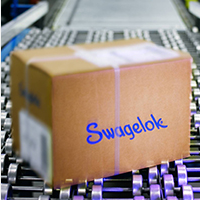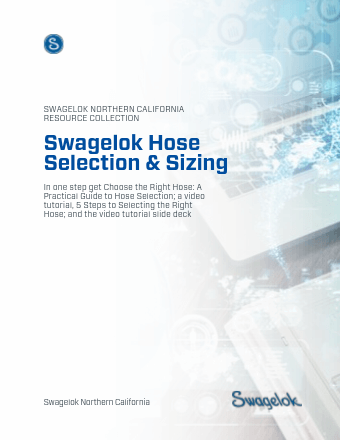Share this
Electrostatic Discharge, Static Dissipation, and Hose
by Jeff Hopkins on 2/12/20 9:00 AM
Pick the right hose and you won't worry about your fluid system getting zapped
"In fluid systems, static discharge can spell disaster."
- From 3 Causes of Static Discharge Disasters
Getting zapped by static electricity can be more than an irritation. In some fluid systems, it can be a disaster. If you are working with petroleum products, paint, lacquer, thinners and other volatile products, a spark is the last thing you want.
That's why selecting the right hose can be crucial. When some kinds of fluids flow through certain kinds of hose, a static charge can build up. The faster the flow, the faster a charge builds up. When it gets high enough, the electric charge will go right through the hose wall to ground itself on the exterior braiding or the nearest end connection.
Back when metal filters were common, that usually helped ground the charge. Today's paper and glass-fiber filters, however, tend to put even more of an electrostatic charge into whatever fluid passes through.
But there are materials that have the ability to alleviate a static electrical charge, having an electrical resistance more than 1×104 ohms but less than 1×1011 ohms. It's called static dissipative materials. Some Swagelok hoses are constructed with carbon black-filled nylon, PTFE, or PFA core material for static dissipation. The intent of a hose being static dissipative is to alleviate any static charge that may build as fluid flows through the hose. So, if your fluid system generates a static charge, you want to use a hose with a conductive metal core, or a PTFE, PFA, or Nylon core with carbon black, to dissipate static rather than discharge it through the hose’s core. Carbon allows the charge to travel to the end connection and exit safely.
Swagelok hose series electrical properties
- All metal hoses (FX, FM, FJ, FL, Convoluted Tube) – These hoses have all metal construction, with the ends welded on, and should always be considered conductive (Note that hoses with conductive cores may also be used in applications where fluid flow generates a static charge. The lower electrical resistance in a conductive core dissipates the charge more readily.)
- Fluoropolymer (PTFE) swaged hoses (T) – With the metal braid and an end connection swaged on, there is intimate contact between the metal braid, collar and end connection. They should be considered conductive, but only static dissipative when the carbon core is used.
- Fluoropolymer (PTFE) crimped hoses (B, X, S, C, J, W) – After crimping, the metal braids have an intimate contact with the collar, but the collar may not be in contact with the end connection due to the design of the collar/insert interface. These hoses have the potential to be conductive, but only static dissipative when the carbon core is used.
- Fluoropolymer (PFA) crimped hoses (U) – After crimping, the teeth of the collar bites down into metal braids, making contact between the two, however, the collar may not be in contact with the end connection due to the design of the collar/insert interface. These hoses have the potential to be conductive, but only static dissipative when the carbon core is used.
- Fluoropolymer (PTFE) crimped hoses (F, N) – These hoses are nonconductive due to the use of a nonconductive braid. The N series hose comes standard with static dissipative carbon core, and it is optional on F series hose. (Note: carbon core does not inherently make a hose conductive, but it does allow for a flow of electrons at a very slow and steady rate - a current of less than 0.00001 amps. A conductive hose has a current flow of 20-100 amps - almost 1 million times the flow. It's like comparing a geyser to a slow drip from a leaky faucet.)

All this can be very confusing, but remember, you never have to guess when it comes to product selection. We make hose right here at Swagelok Northern California. Our technicians can manufacture hose to your specifications, whether you need only one piece or hundreds. Who better to help you select the right materials than the people who will build your order?
Just ask
Swagelok Northern California has a great deal of exposure to all aspects of fluid system design and engineering. Whether you have a simple question or a complex challenge, we're glad to hear from you.
More like this:
Share this
- Archive (465)
- Assembly Services (207)
- About (100)
- Seal Support Systems (96)
- Best Practices (88)
- Training Services (74)
- Fittings (51)
- Semiconductor Applications (49)
- Hoses and Flexible Tubing (47)
- Regulators (44)
- Tubing (42)
- Grab Sampling Systems (32)
- Sampling Systems (32)
- Gas Systems (30)
- Services (30)
- Downloads (29)
- Valves (24)
- Application Support (18)
- Orbital Welding (17)
- Case Studies (13)
- Steam Systems (13)
- Frequently Asked Questions (12)
- Tools (12)
- Measurement Devices (7)
- Subsystems (6)
- Thermal Management (6)
- September 2023 (1)
- August 2023 (2)
- June 2023 (1)
- March 2023 (3)
- February 2023 (3)
- January 2023 (4)
- December 2022 (4)
- November 2022 (4)
- October 2022 (4)
- September 2022 (1)
- August 2022 (3)
- July 2022 (2)
- June 2022 (4)
- May 2022 (1)
- April 2022 (2)
- March 2022 (1)
- February 2022 (2)
- January 2022 (3)
- December 2021 (1)
- November 2021 (6)
- October 2021 (6)
- September 2021 (8)
- August 2021 (4)
- July 2021 (3)
- June 2021 (6)
- May 2021 (6)
- April 2021 (7)
- March 2021 (5)
- February 2021 (4)
- January 2021 (6)
- December 2020 (5)
- November 2020 (6)
- October 2020 (6)
- September 2020 (8)
- August 2020 (7)
- July 2020 (8)
- June 2020 (8)
- May 2020 (6)
- April 2020 (9)
- March 2020 (7)
- February 2020 (10)
- January 2020 (21)
- December 2019 (23)
- November 2019 (21)
- October 2019 (22)
- September 2019 (21)
- August 2019 (22)
- July 2019 (23)
- June 2019 (20)
- May 2019 (23)
- April 2019 (22)
- March 2019 (21)
- February 2019 (20)
- January 2019 (21)
- December 2018 (14)
- November 2018 (19)
- October 2018 (23)
- September 2018 (17)
- August 2018 (29)
- July 2018 (11)
- June 2018 (6)
- May 2018 (5)
- April 2018 (4)
- March 2018 (5)
- February 2018 (3)
- January 2018 (3)
- December 2017 (2)
- November 2017 (4)
- October 2017 (3)
- September 2017 (2)
- August 2017 (6)
- July 2017 (4)
- June 2017 (4)
- May 2017 (4)
- April 2017 (3)
- March 2017 (4)
- February 2017 (3)
- January 2017 (3)
- December 2016 (3)
- November 2016 (3)
- October 2016 (3)
- September 2016 (5)
- August 2016 (5)
- July 2016 (4)
- June 2016 (5)
- May 2016 (3)
- April 2016 (4)
- March 2016 (5)
- February 2016 (11)
- January 2016 (1)
- December 2015 (3)
- November 2015 (4)
- October 2015 (3)
- September 2015 (4)
- August 2015 (4)
- July 2015 (8)
- June 2015 (5)
- May 2015 (3)
- April 2015 (4)
- March 2015 (4)
- February 2015 (3)
- January 2015 (4)
- December 2014 (2)
- November 2014 (3)
- October 2014 (4)
- September 2014 (4)
- August 2014 (4)
- July 2014 (5)
- June 2014 (4)
- May 2014 (4)
- April 2014 (5)
- March 2014 (4)
- February 2014 (3)
- January 2014 (4)
- December 2013 (5)
- November 2013 (3)
- October 2013 (4)
- September 2013 (3)
- August 2013 (5)
- July 2013 (5)
- June 2013 (5)
- May 2013 (3)
- April 2013 (6)
- March 2013 (4)
- February 2013 (4)
- January 2013 (8)
- December 2012 (4)
- November 2012 (6)
- October 2012 (6)
- September 2012 (4)
- August 2012 (4)
- July 2012 (4)
- June 2012 (4)

.webp?width=210&height=70&name=StickyLogo%20(5).webp)


